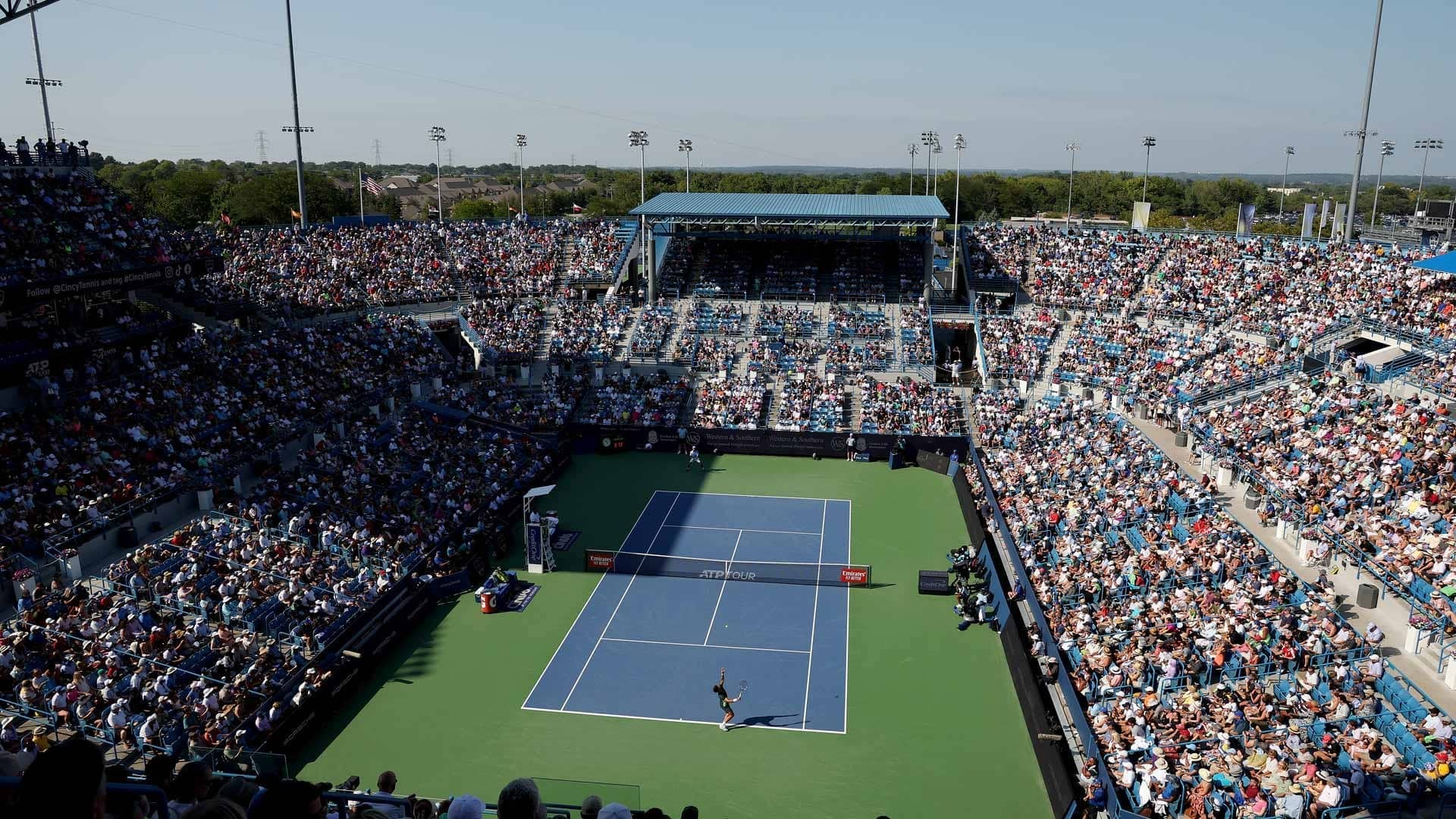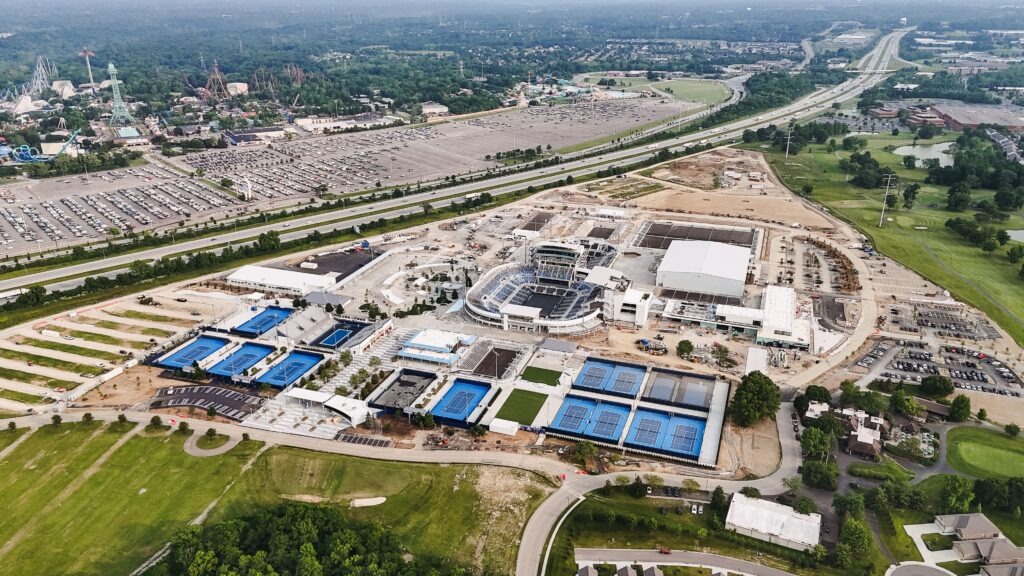 |
An aerial view of Center Court at the Cincinnati Open. Photo: ATP |
The four grand slam tournaments – the Australian Open, Roland Garros, Wimbledon, and the US Open – are the most prestigious events in tennis. Yet, they are constantly evolving and competing with each other, striving to be recognized as the best. This quiet but fierce rivalry fuels ongoing improvements.
Over the past few decades, these major tournaments have seen prize money skyrocket and continuous investment in facilities and services for players, coaches, staff, and spectators. Wimbledon is seeking permission to upgrade the All England Club, aiming to become a true three-week tournament like its counterparts. The other grand slams have already integrated qualifying rounds into their main draws to extend the tournament duration, increasing ticket sales and maximizing profits.
This isn't the only competition among tournament organizers. The BNP Paribas Open, held in Indian Wells, has long held the unofficial title of the "fifth grand slam," a coveted designation, especially since the tournament moved to the Indian Wells Tennis Garden in 2000. Held immediately after the Miami Open, the first Masters 1000 event of the year, Indian Wells, despite similar structure and scale, appears to be losing some of its allure.
The Cincinnati Open, the third and final Masters 1000 tournament in the US, offers players a fully upgraded Lindner Family Tennis Center this year. The $260 million renovation, completed last year, has transformed the complex, located in Mason, Ohio, about a 30-minute drive north of Cincinnati.
The state-of-the-art facility boasts several new structures: a 5,200+ square meter main building on a formerly vacant lot used for parking and walkways, a nearly 1,500 square meter outdoor stadium, a 5,000 square meter tennis center with six indoor courts, and a 1,900+ square meter operations center.
 |
An aerial view of the Cincinnati Open tennis complex. Photo: CO |
World number one women's player, Aryna Sabalenka, remarked at a pre-tournament press conference, "When I first arrived, I was like, ‘What happened here? Where am I?’. I quickly felt much more comfortable compared to the old venue. Before, we used to be crammed together using the facilities in the first few days, when the number of players was highest. But now it's different. I see the tournament has completely changed".
The Lindner Family Tennis Center's reconstruction added 13 new courts, including one with a 2,300-seat capacity. The grounds expanded from 81,000 to 162,000 square meters. Lawns, flower beds, and thousands of trees, including over 2,000 newly planted trees and shrubs, enhance the complex, transforming it into a park-like setting.
Another significant improvement is the replacement of the black asphalt, which used to radiate heat during Southern Ohio summers, with grass, gravel, and decorative stone. Indoor facilities, like the main building, which can be used as a restaurant, will be open year-round for local residents and tourists.
2017 Roland Garros champion Jelena Ostapenko said, "I feel like I’m playing at the fifth grand slam. They renovated and made these changes in just one year? It’s unbelievable".
However, not everything has gone smoothly. Earlier this week, a power outage disrupted electronic line calling and television broadcasts. During Jannik Sinner's third-round victory over Gabriel Diallo, a false fire alarm caused further disruption. The lack of covered courts in the newly upgraded complex also drew criticism from spectators during rain.
These aren't the only drawbacks for the Cincinnati Open in its grand slam pursuit. Indian Wells offers higher and more equitable prize money. The Cincinnati women’s singles champion receives $752,275, less than the $1.1 million awarded to the men’s singles champion. This disparity is significantly smaller at Indian Wells, where Mirra Andreeva and Jack Draper received $1.1 million and $1.2 million, respectively.
 |
Jannik Sinner lifts the men's singles trophy last year. Photo: ATP |
Indian Wells also surpasses Cincinnati in terms of attendance, partly due to its tradition and favorable location. Over 500,000 fans attended the tournament in March in California, located about 160 km from Los Angeles and near the popular Palm Springs resort area. Meanwhile, the Cincinnati Open, held in Mason, a city with a population of over 30,000, is expected to draw around 300,000 spectators this year.
If any tournament poses a threat to Indian Wells, it's the Rome Masters. The Italian Tennis and Padel Federation (FITP) submitted a proposal with a $591 million offer to "acquire" the Madrid Open's slot on the tournament schedule. This bold move aims to eliminate the Spanish Masters 1000 event, extending the Rome Masters into a three-week tournament. Coupled with plans for a comprehensive upgrade of the Foro Italico complex, the FITP aims to transform the Italian event into a grand slam.
The FITP's draft proposal includes $67 million to renovate the main court, including the installation of a retractable roof, expected to be completed by 2028, and adding 2,000 seats, increasing capacity to 12,500. This year's Rome Masters also introduced three new courts, expanding the Foro Italico from 12 to 20 hectares.
FITP President Angelo Binaghi said at the conclusion of the 2025 Rome Masters, "Is there anywhere else in the world where a monopoly has lasted for over 100 years like the grand slams? Why are there only four, and always the same ones? This is completely unfair and prevents tennis from developing".
Significant hurdles remain for both the Rome Masters and Indian Wells. However, the ambitious goals of these Masters 1000 events not only elevate their status but also benefit the ATP and WTA, organizations also vying for influence with the four grand slams.
Vy Anh












